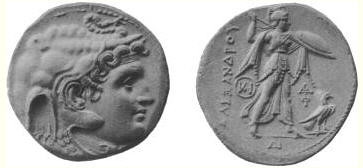
PREV ARTICLE
FULL ISSUE
PREV FULL ISSUE
FEATURED WEB PAGE: HISTORIA NUMORUM EGYPTThis week's Featured Web Page is the Egypt section of the Digital Historia Numorum from Ed Snible's web site. It is a digital version of Barclay Head's 1911 work, Historia Numorum: A Manual of Greek Numismatics.

Silver was a common medium of exchange; but, when it passed from hand to hand, its precise value was always determined by weighing. As Dressel has pointed out (Z. f. N., xxii, pp. 231 ff.), there is no other satisfactory explanation of phenomena like the so-called ‘silversmith's hoard' from Naucratis, a find which contained fifteen archaic silver coins of various Greek cities together with 42 oz. of roughly cast and cut up lumps of silver (Num. Chron., 1886, p. 4; cf. for other instances ibid., 1890, pp. 1 ff., and 1899, pp. 269 ff.). The institution of a regular coinage dates from the reign of Alexander the Great, some of whose AV staters and AR tetradrachms are undoubtedly of Egyptian origin. The monarchy that followed the empire of Alexander lasted until Egypt was absorbed by Rome. Consequently civic issues are not to be looked for.
www.snible.org/coins/hn/egypt.htmlWayne Homren, Editor The Numismatic Bibliomania Society is a non-profit organization promoting numismatic literature. See our web site at coinbooks.org. To submit items for publication in The E-Sylum, write to the Editor at this address: whomren@gmail.com To subscribe go to: https://my.binhost.com/lists/listinfo/esylum All Rights Reserved. NBS Home Page Contact the NBS webmaster 
|